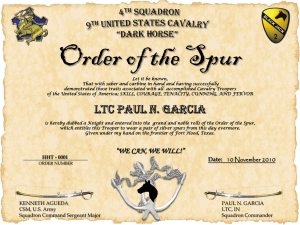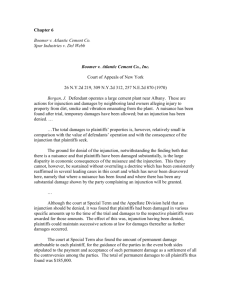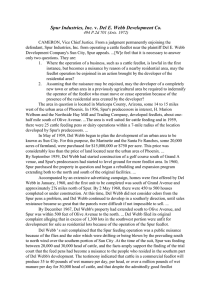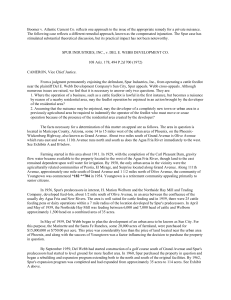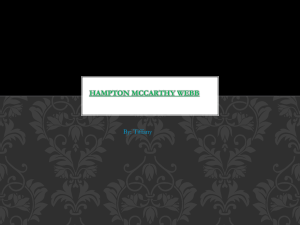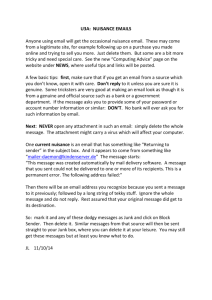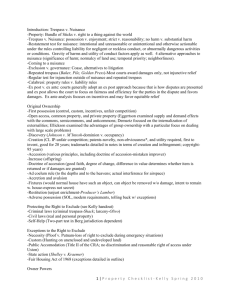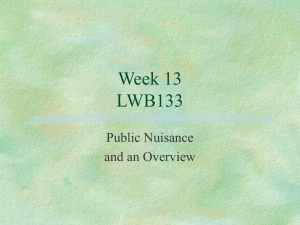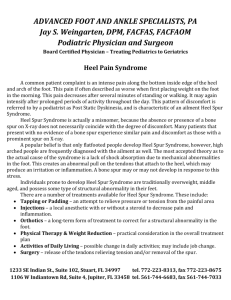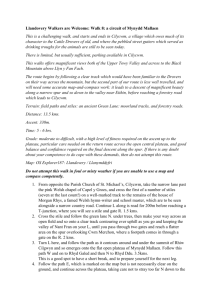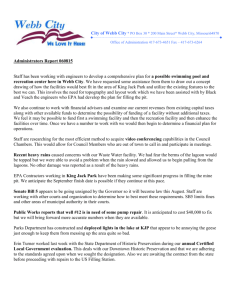Spur Industries, Inc. v. Del E. Webb Development Co.
advertisement
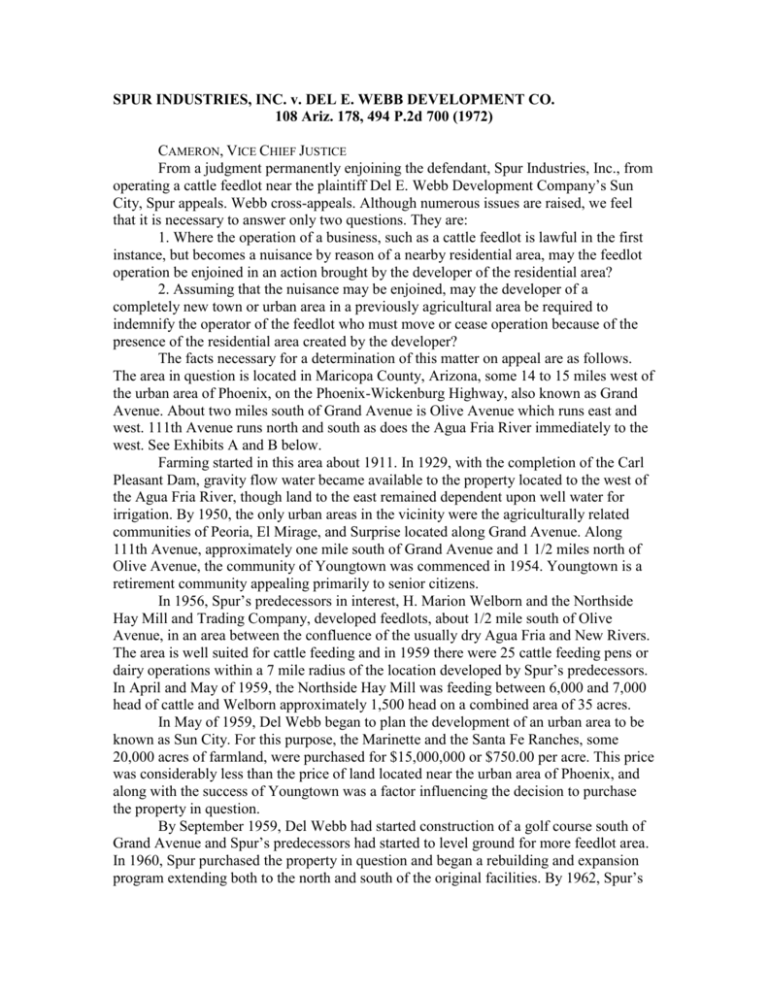
SPUR INDUSTRIES, INC. v. DEL E. WEBB DEVELOPMENT CO. 108 Ariz. 178, 494 P.2d 700 (1972) CAMERON, VICE CHIEF JUSTICE From a judgment permanently enjoining the defendant, Spur Industries, Inc., from operating a cattle feedlot near the plaintiff Del E. Webb Development Company’s Sun City, Spur appeals. Webb cross-appeals. Although numerous issues are raised, we feel that it is necessary to answer only two questions. They are: 1. Where the operation of a business, such as a cattle feedlot is lawful in the first instance, but becomes a nuisance by reason of a nearby residential area, may the feedlot operation be enjoined in an action brought by the developer of the residential area? 2. Assuming that the nuisance may be enjoined, may the developer of a completely new town or urban area in a previously agricultural area be required to indemnify the operator of the feedlot who must move or cease operation because of the presence of the residential area created by the developer? The facts necessary for a determination of this matter on appeal are as follows. The area in question is located in Maricopa County, Arizona, some 14 to 15 miles west of the urban area of Phoenix, on the Phoenix-Wickenburg Highway, also known as Grand Avenue. About two miles south of Grand Avenue is Olive Avenue which runs east and west. 111th Avenue runs north and south as does the Agua Fria River immediately to the west. See Exhibits A and B below. Farming started in this area about 1911. In 1929, with the completion of the Carl Pleasant Dam, gravity flow water became available to the property located to the west of the Agua Fria River, though land to the east remained dependent upon well water for irrigation. By 1950, the only urban areas in the vicinity were the agriculturally related communities of Peoria, El Mirage, and Surprise located along Grand Avenue. Along 111th Avenue, approximately one mile south of Grand Avenue and 1 1/2 miles north of Olive Avenue, the community of Youngtown was commenced in 1954. Youngtown is a retirement community appealing primarily to senior citizens. In 1956, Spur’s predecessors in interest, H. Marion Welborn and the Northside Hay Mill and Trading Company, developed feedlots, about 1/2 mile south of Olive Avenue, in an area between the confluence of the usually dry Agua Fria and New Rivers. The area is well suited for cattle feeding and in 1959 there were 25 cattle feeding pens or dairy operations within a 7 mile radius of the location developed by Spur’s predecessors. In April and May of 1959, the Northside Hay Mill was feeding between 6,000 and 7,000 head of cattle and Welborn approximately 1,500 head on a combined area of 35 acres. In May of 1959, Del Webb began to plan the development of an urban area to be known as Sun City. For this purpose, the Marinette and the Santa Fe Ranches, some 20,000 acres of farmland, were purchased for $15,000,000 or $750.00 per acre. This price was considerably less than the price of land located near the urban area of Phoenix, and along with the success of Youngtown was a factor influencing the decision to purchase the property in question. By September 1959, Del Webb had started construction of a golf course south of Grand Avenue and Spur’s predecessors had started to level ground for more feedlot area. In 1960, Spur purchased the property in question and began a rebuilding and expansion program extending both to the north and south of the original facilities. By 1962, Spur’s expansion program was completed and had expanded from approximately 35 acres to 114 acres. See Exhibit A above. Accompanied by an extensive advertising campaign, homes were first offered by Del Webb in January 1960 and the first unit to be completed was south of Grand Avenue and approximately 2 1/2 miles north of Spur. By 2 May 1960, there were 450 to 500 houses completed or under construction. At this time, Del Webb did not consider odors from the Spur feed pens a problem and Del Webb continued to develop in a southerly direction, until sales resistance became so great that the parcels were difficult if not impossible to sell.... By December 1967, Del Webb’s property had extended south to Olive Avenue and Spur was within 500 feet of Olive Avenue to the north. See Exhibit B above. Del Webb filed its original complaint alleging that in excess of 1,300 lots in the southwest portion were unfit for development for sale as residential lots because of the operation of the Spur feedlot. Del Webb’s suit complained that the Spur feeding operation was a public nuisance because of the flies and the odor which were drifting or being blown by the prevailing south to north wind over the southern portion of Sun City. At the time of the suit, Spur was feeding between 20,000 and 30,000 head of cattle, and the facts amply support the finding of the trial court that the feed pens had become a nuisance to the people who resided in the southern part of Del Webb’s development. The testimony indicated that cattle in a commercial feedlot will produce 35 to 40 pounds of wet manure per day, per head, or over a million pounds of wet manure per day for 30,000 head of cattle, and that despite the admittedly good feedlot management and good housekeeping practices by Spur, the resulting odor and flies produced an annoying if not unhealthy situation as far as the senior citizens of southern Sun City were concerned. There is no doubt that some of the citizens of Sun City were unable to enjoy the outdoor living which Del Webb had advertised and that Del Webb was faced with sales resistance from prospective purchasers as well as strong and persistent complaints from the people who had purchased homes in that area. Trial was commenced before the court with an advisory jury. The advisory jury was later discharged and the trial was continued before the court alone. Findings of fact and conclusions of law were requested and given. The case was vigorously contested, including special actions in this court on some of the matters. In one of the special actions before this court, Spur agreed to, and did, shut down its operation without prejudice to a determination of the matter on appeal. On appeal the many questions raised were extensively briefed. It is noted, however, that neither the citizens of Sun City nor Youngtown are represented in this lawsuit and the suit is solely between Del E. Webb Development Company and Spur Industries, Inc. May Spur Be Enjoined? The difference between a private nuisance and a public nuisance is generally one of degree. A private nuisance is one affecting a single individual or a definite small number of persons in the enjoyment of private rights not common to the public, while a public nuisance is one affecting the rights enjoyed by citizens as a part of the public. To constitute a public nuisance, the nuisance must affect a considerable number of people or an entire community or neighborhood. Where the injury is slight, the remedy for minor inconveniences lies in an action for damages rather than in one for an injunction. Moreover, some courts have held, in the “balancing of conveniences” cases, that damages may be the sole remedy. See Boomer v. Atlantic Cement Co., 26 N.Y.2d 219, 309 N.Y.S.2d 312, 257 N.E.2d 870, 40 A.L.R.3d 590 (1970), and annotation comments, 40 A.L.R.3d 601. Thus, it would appear from the admittedly incomplete record as developed in the trial court, that, at most, residents of Youngtown would be entitled to damages rather than injunctive relief. We have no difficulty, however, in agreeing with the conclusion of the trial court that Spur’s operation was an enjoinable public nuisance as far as the people in the southern portion of Del Webb’s Sun City were concerned. §36-601, subsec. A reads as follows: §36-601. Public nuisances dangerous to public health A. The following conditions are specifically declared public nuisances dangerous to the public health: 1. Any condition or place in populous areas which constitutes a breeding place for flies, rodents, mosquitoes and other insects which are capable of carrying and transmitting disease-causing organisms to any person or persons. By this statute, before an otherwise lawful (and necessary) business may be declared a public nuisance, there must be a “populous” area in which people are injured: ... [I]t hardly admits a doubt that, in determining the question as to whether a lawful occupation is so conducted as to constitute a nuisance as a matter of fact, the locality and surroundings are of the first importance. (citations omitted) A business which is not per se a public nuisance may become such by being carried on at a place where the health, comfort, or convenience of a populous neighborhood is affected.... What might amount to a serious nuisance in one locality by reason of the density of the population, or character of the neighborhood affected, may in another place and under different surroundings be deemed proper and unobjectionable.... [MacDonald v. Perry, 255 P. 494, 497 (Ariz. 1927).] It is clear that as to the citizens of Sun City, the operation of Spur’s feedlot was both a public and a private nuisance. They could have successfully maintained an action to abate the nuisance. Del Webb, having shown a special injury in the loss of sales, had a standing to bring suit to enjoin the nuisance. The judgment of the trial court permanently enjoining the operation of the feedlot is affirmed. Must Del Webb Indemnify Spur? A suit to enjoin a nuisance sounds in equity and the courts have long recognized a special responsibility to the public when acting as a court of equity: §104. Where public interest is involved. Courts of equity may, and frequently do, go much further both to give and withhold relief in furtherance of the public interest than they are accustomed to go when only private interests are involved. Accordingly, the granting or withholding of relief may properly be dependent upon considerations of public interest.... [27 Am. Jur. 2d, Equity, page 626.] In addition to protecting the public interest, however, courts of equity are concerned with protecting the operator of a lawfully, albeit noxious, business from the result of a knowing and willful encroachment by others near his business. In the so-called “coming to the nuisance” cases, the courts have held that the residential landowner may not have relief if he knowingly came into a neighborhood reserved for industrial or agricultural endeavors and has been damaged thereby: Plaintiffs chose to live in an area uncontrolled by zoning laws or restrictive covenants and remote from urban development. In such an area plaintiffs cannot complain that legitimate agricultural pursuits are being carried on in the vicinity, nor can plaintiffs, having chosen to build in an agricultural area, complain that the agricultural pursuits carried on in the area depreciate the value of their homes. The area being primarily agricultural, any opinion reflecting the value of such property must take this factor into account. The standards affecting the value of residence property in an urban setting, subject to zoning controls and controlled planning techniques, cannot be the standards by which agricultural properties are judged. People employed in a city who build their homes in suburban areas of the county beyond the limits of a city and zoning regulations do so for a reason. Some do so to avoid the high taxation rate imposed by cities, or to avoid special assessments for street, sewer and water projects. They usually build on improved or hard surface highways, which have been built either at state or county expense and thereby avoid special assessments for these improvements. It may be that they desire to get away from the congestion of traffic, smoke, noise, foul air and the many other annoyances of city life. But with all these advantages in going beyond the area which is zoned and restricted to protect them in their homes, they must be prepared to take the disadvantages. [Dill v. Excel Packing Company, 331 P.2d 539, 548, 549 (Kan. 1958).] And: ... a party cannot justly call upon the law to make that place suitable for his residence which was not so when he selected it.... [Gilbert v. Showerman, 23 Mich. 448, 455, 2 Brown 158 (1871).] Were Webb the only party injured, we would feel justified in holding that the doctrine of “coming to the nuisance” would have been a bar to the relief asked by Webb, and, on the other hand, had Spur located the feedlot near the outskirts of a city and had the city grown toward the feedlot, Spur would have to suffer the cost of abating the nuisance as to those people locating within the growth pattern of the expanding city: The case affords, perhaps, an example where a business established at a place remote from population is gradually surrounded and becomes part of a populous center, so that a business which formerly was not an interference with the rights of others has become so by the encroachment of the population.... [City of Ft. Smith v. Western Hide & Fur Co., 239 S.W. 724, 726 (Ark. 1922).] We agree, however, with the Massachusetts court that: The law of nuisance affords no rigid rule to be applied in all instances. It is elastic. It undertakes to require only that which is fair and reasonable under all the circumstances. In a commonwealth like this, which depends for its material prosperity so largely on the continued growth and enlargement of manufacturing of diverse varieties, “extreme rights” cannot be enforced.... [Stevens v. Rockport Granite Co., 104 N.E. 371, 373 (Mass. 1914).] There was no indication in the instant case at the time Spur and its predecessors located in western Maricopa County that a new city would spring up, full-blown, alongside the feeding operation and that the developer of that city would ask the court to order Spur to move because of the new city. Spur is required to move not because of any wrongdoing on the part of Spur, but because of a proper and legitimate regard of the courts for the rights and interests of the public. Del Webb, on the other hand, is entitled to the relief prayed for (a permanent injunction), not because Webb is blameless, but because of the damage to the people who have been encouraged to purchase homes in Sun City. It does not equitably or legally follow, however, that Webb, being entitled to the injunction, is then free of any liability to Spur if Webb has in fact been the cause of the damage Spur has sustained. It does not seem harsh to require a developer, who has taken advantage of the lesser land values in a rural area as well as the availability of large tracts of land on which to build and develop a new town or city in the area, to indemnify those who are forced to leave as a result. Having brought people to the nuisance to the foreseeable detriment of Spur, Webb must indemnify Spur for a reasonable amount of the cost of moving or shutting down. It should be noted that this relief to Spur is limited to a case wherein a developer has, with foreseeability, brought into a previously agricultural or industrial area the population which makes necessary the granting of an injunction against a lawful business and for which the business has no adequate relief. It is therefore the decision of this court that the matter be remanded to the trial court for a hearing upon the damages sustained by the defendant Spur as a reasonable and direct result of the granting of the permanent injunction. Since the result of the appeal may appear novel and both sides have obtained a measure of relief, it is ordered that each side will bear its own costs. Affirmed in part, reversed in part, and remanded for further proceedings consistent with this opinion. NOTES AND QUESTIONS 1. More about Spur. Do you understand the court in Spur Industries to hold that an injunction will be more readily granted when the defendant is found to be maintaining a public rather than only a private nuisance? Could Del E. Webb Development Co. have secured any relief at all if the court had classified the nuisance as solely private in character? Suppose the action had been brought by the Sun City municipal attorney, or as a class action by a substantial number of Sun City residents? Would the relief granted have been the same? Upon remand, how should the trial court frame its judgment? Should the injunction be conditioned on tender of the damages assessed by the court to Spur Industries, or should payment of the damages be conditioned on compliance with the injunction against continued operation of Spur Industries’ feedlot? For an update on Sun City, see Shetter, Sun City Holds On, Planning, Vol. 62, No. 1, at 16 (1996) (huge success of development leads to construction of eight more cities by Del Webb in other areas; average age of residents is 74.4 years). 2. Compensated injunctions. The court says this remedy is available only in very narrow circumstances: “wherein a developer has, with foreseeability, brought into a previously agricultural or industrial area the population which makes necessary the granting of an injunction against a lawful business and for which the business has no adequate relief.” Why this limitation? Are the factual differences between Spur and Boomer significant? Is there any party in Boomer comparable to Del Webb, who can be assessed the “cost” of the injunction? Isn’t the point of Boomer that the cement plant should be kept open because of its economic effect on the region? Would the Arizona court refuse to follow Boomer? Does Boomer, like Spur, show an appreciation that compensation can be used to bridge the gap between otherwise incompatible land use claims. 3. A compensation model. In an article contemporaneous with the decision in Spur Industries (neither cites the other), Calabresi and Melamed worked out a general model based on the Coase Theorem that led to the same result. They posited that an entitlement (i.e., a property right) to use a natural resource (e.g., clean air) may be allocated either to the plaintiff or the defendant in a nuisance case, and that this entitlement may be protected either by an injunction (a property rule) so that the entitlement may be taken away only by one who obtains the permission of the owner of the entitlement, or by an award of damages (a liability rule) so that the entitlement may be taken away by one who pays judicially determined compensatory damages. The authors reasoned that, since an entitlement may initially be allocated to either of the parties and can be protected either by an injunction or by an award of damages, there must be four possible outcomes in nuisance cases, rather than only the three traditionally found in court decisions. Thus in addition to finding no nuisance, or finding nuisance and granting an injunction, or finding nuisance and awarding only damages, Calabresi and Melamed concluded that courts should be free to grant an injunction and require the plaintiff to pay damages to compensate the defendant for the loss caused by the injunction, arguing that through choice among all four possible outcomes, courts can do a better job in achieving both economic efficiency and fairness than is possible when they limit themselves to the three traditional outcomes. See Calabresi & Melamed, Property Rules, Liability Rules, and Inalienability: One View of the Cathedral, 85 Harv. L. Rev. 1089 (1972). For commentary on the thesis advanced by Calabresi and Melamed, see Kaplow & Shavell, Property Rules Versus Liability Rules: An Economic Analysis, 109 Harv. L. Rev. 713 (1996); Krier & Schwab, The Cathedral at Twenty-Five: Citations and Impressions, 106 Yale L.J. 2121 (1997); Rose, The Shadow of the Cathedral, 106 Yale L.J. 2175 (1997). Ellickson, supra, argues that “[n]uisance law would function better if, in general, a plaintiff in a nuisance case were limited to choosing between the remedies of ... damages ... [or] compensated injunction,” which would permit the plaintiff to enjoin the defendant’s conduct, but only if he compensates the defendant for the defendant’s losses caused by the injunction.... A rebuttable presumption against ... injunctions [without compensation] should exist in nuisance cases, and be overcome only when the plaintiff can show that his personal safety or fundamental freedoms are vitally threatened by the defendant’s activity. [Ellickson, Alternatives to Zoning: Covenants, Nuisance Rules, and Fines as Land Use Controls, 40 U. Chi. L. Rev. 681, 738-48 (1973).]

